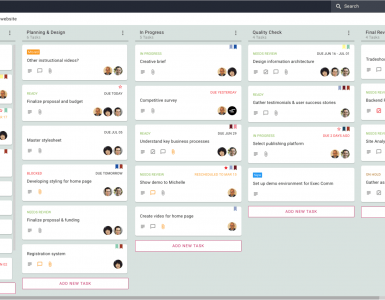Ever feel the creative itch inside you when you see animated characters on a screen?
If you’ve ever wanted to combine your love of animation with your creative skills (and get paid for it), then starting a career in animation is a great idea!
However, it’s likely you don’t know where to start when it comes to gaining experience and getting your foot in the door of the animation industry.
Not to fear! Here’s our ultimate guide on how to start a career in animation:
Get Qualified
Going to school scoring a degree might be the first thing that comes to your mind when you think of a career in animation. The degree you choose should be influenced by career goals, prior education and current skills.
However, you should probably keep this in mind:
A bachelor’s degree in animation can pave the path for a career in web design, illustration work and film editing. Research shows that 25% of animation graduates become graphic designers and 16% become artists.
You’ll be able to build on a number of key skills that’ll serve you well in a number of industries by learning more about conceptualization and cinematography.
Take your pick from a number of programs, be it a traditional degree or diploma course at a University or a simple online course. There are both foundational and advanced courses, meaning you’ll be able to select a program that’s best-suited to your current skills and abilities.
On the flipside, non degree programs help you specialize in certain styles of animation (such as frame-by-frame animation or 3D animation).
Whatever you decide, choose something that gives you plenty of practice and brings you up-to-date with current industry practice. This will enable you to negotiate a higher rate for your services, whether you go the freelance route or opt for an in-house role.
Get Certified In Relevant Applications
Certificates offered by animation software companies can be immensely helpful in shaping your career. The most widely-recognised software certifications are in Adobe products, which will show potential employers or freelance clients that you’re proficient in relevant applications to the role.
Commit To Developing Your Skills
It doesn’t matter how comprehensive your chosen program is, (or how good the teachers are).
They can only teach you so much, and they can only push you so far.
Ultimately, what matters is the amount of hard work you put into what you do. Learning animation is far more than mastering the foundations.
Here are the skills you need to learn:
1. Observation Skills
You need to develop observation skills. When you improve at observing people, you start understanding body language better. This starts to reflect in your animation work.
Being able to observe and apply body movements in your work is one of the hallmarks of a good animator. Teamwork is another biggie; most projects require you to collaborate with similar-minded people. That’s why you need to research and learn from people.
2. Drawing Skills
Another basic skill is learning how to draw. Animation is heavily focused around traditional drawing skills.
As an aspiring animator, you ideally want to build on these skills as much as possible.
So, what should you do?
Learn figure drawing so that you can make sure that your frames are proportional and convincing. You should practice drawing whenever you have the time to, working with a number of subjects & briefs to ensure your drawing skills are the very best they can be.
3. Graphic Design
As mentioned a little bit earlier on in this guide, many animators go on to work as graphic designers.
Plus, businesses are currently hiring graphic designers in overwhelming quantities
That’s why it’s key to know the ins and outs of graphic design as an adjacent industry. If you choose to become a freelance animator, graphic design skills can also help to supplement your work during quiet periods.
Create A Stellar Portfolio + Demo Reel
Studios care about one thing.
Here’s a hint: It’s not your school or your grades.
It’s your demo reel.
Make sure you get plenty of feedback on your demo reel and improve it accordingly. It’s important to make sure you do this before you send it out to prospective clients or employers in order to make sure it’s the very best it can be.
But you might be wondering:
Why is a demo reel so important?
Well, a demo reel can showcase the work you’ve done outside of school. However, more importantly, your demo reel shows what you’re good at and makes the case for why a business or client should hire you.
Keep in mind that an animation designer can work in several industries, so it’s better to gear your demo reels and portfolios to the kind of industry you’re applying for.
It’s ideal to host your demo reel online on a platform such as Twine, especially when you’re displaying more extensive or lengthy work samples. The demo reel should show a recap and project goals; make sure you include sections that show your core interests and key skills.
Gain As Much Work Experience As Possible
Get paid to animate and design starting right now. Start working for businesses at every chance you get when you are in school. Don’t worry if some or even most of the work at this stage doesn’t get you paid; the most important thing is that you gain experience.
Internships and freelance animation jobs are your gateway to gain experience. While your tutors can serve as a good resource to connect with industry professionals, don’t rely on them to make it happen for you.
Take it upon yourself to contact agencies, print out brochures and posters with custom QR codes leading back to your portfolio page and apply to jobs on freelance sites. Not only will you advance your industry knowledge, but you’ll also develop important soft skills such as communicating with a client or staying productive when working remotely.
Once you’re in a full time role, you’re likely to be at an entry level position. As you progress, the experience of working with so many people (and on so many animation projects) will help you improve your networking skills. The success you enjoy depends largely on how well you hone your basic skills, so it’s spend time getting as much exposure as you can.
Internships and freelance work will boost the number of chances you get for work experience. As an intern, you also might get a chance to shadow some extremely experienced animators, who should provide a few golden nuggets on navigating the industry and securing work.
Decide On A Niche
It’s easy to assume that animation is an easy job.
In fact, it’s quite the opposite.
Long hours, gradual progress and constant revisions characterizes each project you undertake, despite how long or short the final animated video is.
Many specialized teams handle each unique part of the animation and production process; this starts by conceptualizing the idea first and then bringing it to life with character movements.
There are several niches within animation that you might choose to go into:
1. Storyboarding
Once the team develops an idea and the script is ready, the details need to be sketched out using a storyboard that details the sequence of events characters follow.
For this, the artist begins by creating the storyboard and narrating the path of each character.
The artists go on to create visuals for the scene including poses, expressions and backgrounds the characters would be sharing.
2. Modelling
The model brings the characters and scene into real life with 3D computer models of the characters and everything else for the CGI project.
They are known for creating whatever you see on the screen. They create the props and sets required to achieve the director’s vision.
3. Production
The characters are then brought to life with animators, who can either be 2D animators or 3D animators.
The traditional role of a 2D animator is to create drawings by hand. They’ll draw pictures where each movement is drawn by hand and then photographed at 24 frames per second.
Traditional animation is still done by hand, but animation software can help to significantly speed up the process.
3D animation is a little different:
- 3D animation is a realistic portrait using 3D software programs
- 3D animators add depth and height to a character and add movements.
- Editing & revision is easy as it’s done within computer software (rather than having to be re-drawn)
3D animation is way simpler as the bulk of the actual animation is handled by the software itself.
4. Rigging
The rigging artist specializes in designing and maintaining a smooth and efficient rig.
But what exactly is a rig?
A rig is where animators add bones to a character and bind it to skin to make it look realistic. A rigging artist works with a model to ensure that the movements they’re looking for are actually possible.
Here’s what a rigging artist should know:
- How to create life-like rigs for 3D characters using a software tool called MAYA .
- How to create rigs for 3D vehicles and props for animation
- How to work with the director to create rigs that match their vision.
- How to maintain team dynamics
- How to hone a good sense of autonomy
- Some experience with the Python coding language.
5. Compositing
Compositors work at the end of the production process and build the final image by merging all the layers of previously created materials.
Whether you’re making a marketing video or a short film, compositors are needed everywhere.
Consider it similar to the job of a film editor who studies reel after reel, bringing it all together for the movie or commercial.
Wrapping Up
A career in animation is never easy. There’s a lot of work and a lot of knowledge needed to survive and thrive within the role.
You need to:
- Learn and master new tools and software
- Learn to work in a team
- Be able to work within a creative environment
But, all said and done, the career of an animator is highly rewarding.
What do you think of the animation tips and tricks I listed? Do let us know in the comments below!










